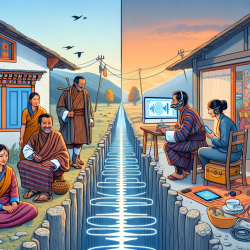Understanding the Digital Divide in the Bhutanese Refugee Community
The digital divide represents a significant barrier to accessing information and healthcare, particularly for marginalized communities like the Bhutanese refugees in the U.S. According to the research article "Exploring the Digital Divide among the Bhutanese Refugee Community during COVID-19: Engaged Research in Action," the divide is not merely a technological issue but is deeply intertwined with socio-cultural and socio-environmental factors.
Key Findings and Implications for Practitioners
The study, conducted through a community-academic partnership, highlights several critical insights:
- Complexity Beyond Technology: The digital divide is not just about access to devices and the internet. It is also about the historical inequalities and socio-cultural barriers that impact technology use and engagement.
- Education and Skills Matter: Access to the internet does not equate to equitable engagement. Educational attainment and digital literacy are crucial for effective use of online resources.
- Community Engagement is Essential: Solutions to bridge the digital divide must involve the community as active partners. This includes co-producing research and developing culturally relevant interventions.
Strategies for Practitioners
For practitioners working with the Bhutanese refugee community, or similar groups, consider the following strategies:
- Enhance Digital Literacy: Develop programs that improve digital literacy, focusing on both technological skills and the socio-cultural context of technology use.
- Foster Community Partnerships: Engage with community leaders and members to co-create solutions that address their specific needs and cultural contexts.
- Provide Culturally Responsive Services: Ensure that online therapy and telehealth services are culturally sensitive and linguistically appropriate to increase accessibility and trust.
Encouraging Further Research
Practitioners are encouraged to delve deeper into the dynamics of the digital divide within their specific contexts. By understanding the unique challenges and leveraging community strengths, practitioners can develop more effective interventions that promote digital inclusion and improve health outcomes.
To read the original research paper, please follow this link: Exploring the Digital Divide among the Bhutanese Refugee Community during COVID-19: Engaged Research in Action.










